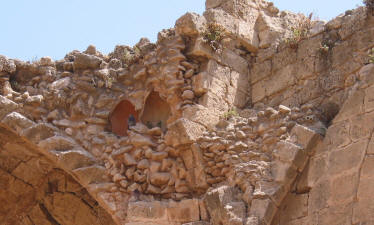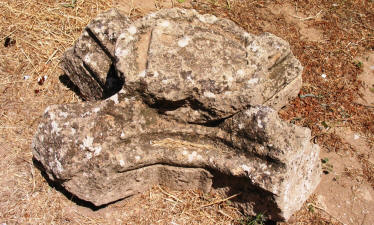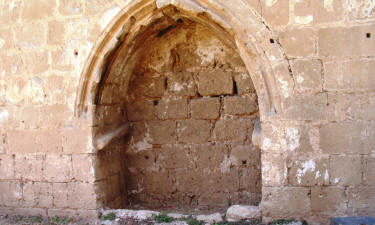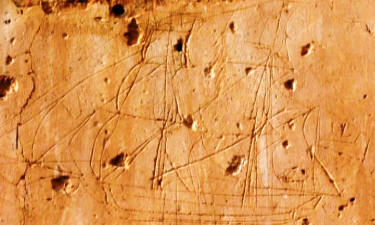St George of the Greeks Church,
Famagusta, North Cyprus
 |
| St George of the Greeks Church |
St George of the Greeks is to be found in the south east quadrant of Famagusta.
Cyprus was one of the earliest converts to Christianity, and, as part of the Byzantine Empire, its particular form of Christianity was Orthodox. There were some basic doctrinal differences between Orthodox Christianity centred in Constantinople, and Latin Christianity, centred in Rome. The two churches had begun to drift apart fairly early on because of cultural and language differences. As western culture was gradually transformed by an influx of Germanic people, the east continued with an unbroken tradition of Hellenistic Christianity.
 |
| Weight saving Pots |
In 1043, Michael Cerularius became patriarch in Constantinople. In reaction to the Pope's intervention in the affairs of Byzantine churches in southern Italy, he began a campaign against the Latin churches in his own city, eventually closing them.
In 1054, Cardinal Humbert was sent from Rome to Constantinople to deal with the problem. His answer was to excommunicate the Patriarch, his colleagues, and by implication, the entire Greek church. After a few days, the Patriarch responded in kind. Later events, such as the sacking of Constantinople in 1204, during the 4th Crusade, confirmed the rift, and efforts to heal it have never been successful, although the mutual excommunications were cancelled by Pope Paul VI and Patriarch Athenagoras I in 1965 as part of an effort to draw the churches closer together.
 |
| A Central Roof Capstone |
When the Lusignans (who, of course, were French Catholic) took over the island in 1191, they inherited an island that was predominately eastern Orthodox. They greatly reduced the power of the church, cutting the number of bishops from 14 to 4, and placing them under the Catholic bishop for the area.
 |
| The Dome in the Apse |
The southeast corner of Famagusta became the Greek quarter, and there are still several churches remaining, all within close proximity.
St George of the Greeks, not to be confused with the similarly named St George of the Latins, is the second largest church in Famagusta, and during the middle ages it served as the Cathedral for the Greek Orthodox community.
 |
| Surviving Frescoes |
The church was built around 1300, to the west of a much earlier church dedicated to St George, around the same time as the Latin St Nicholas Cathedral (now the Lala Mustafa Pasha Mosque). Although there was a perfectly serviceable cathedral church, the tiny St Simeon, which abuts George of the Greeks, the Orthodox community wanted to construct something that rivalled the Latin cathedral. It was built in the style of a Latin Church, with a wide central nave, 2 side aisles and huge columns that held up the nave vaulting. Indeed, it has been suggested that the same builders built both cathedrals.
Have a look at the remaining columns, and you will see they were originally much more slender. However, they proved to be insufficient to support the weight of the roof, and compression fractures began to appear. At some point, the builders had to add the collars that you see to support the extra weight. If you look closely you can see the remains of the iron clamps that were used to hold the blocks together.
 |
| A Founder's Tomb |
While we're looking at columns, try and picture the church with its roof intact. Follow the thin corbels up the wall, and extend them in your imagination. This is where they became the ribs of the roof. Where they met, they were joined together by huge capstones. Although the roof is long gone, you can still see several examples of these elaborately carved keystones, in the form of a cross, where the ribs met in the centre of the roof, and lying, probably where, they fell hundreds of years ago.
 |
| Used as a Shooting Gallery during British Times |
The architects were obviously worried about the weight that the columns had to support. Look high up in the corners, towards the apse. Here you can see some of the huge pots that the builders placed in amongst the rubble in order to make the walls lighter.
A drawing of the church from the 18th century shows a dome on the church, not unlike the one on the nearby St Nikolas church, an octagonal drum with a dome on top. But even with the extra support added to the pillars, eventually the dome fell.
 |
| A Ship's Etching on the Plaster |
The apse was at one time filled with vibrant frescoes, some of which can be seen to this day. There was probably a depiction of Christ Pandokrator, ruler of the universe, in the dome above, and an image of the crucifixion is still just about discernable. At some point, the apse was used as a shooting gallery, and there is much evidence in the form of bullet holes to be seen.
The church was not only used as a shooting gallery, however. By the18th century, the walled city was more or less abandoned, with only a handful of people living in mud brick houses attached to the decaying churches. Sailors from the nearby port would disembark and come into the city, and etch drawings of their ships into the plaster of the derelict churches. Some of these etchings can be seen at the western end of the church. A passing glance would miss them, but they are readily visible if you are looking for them.
 |
| Siege Damage From 1571 |
Along the walls of the church, you can see several arched niches. These were the tombs of the patrons of the church. The sarcophagus was at ground level, while the brackets you can see would have held a stone slab, probably with an effigy of the deceased carved on it. It is believed that these niches were built after the walls, and their construction further weakened the roof support.
During the Ottoman siege of the city in 1570-71, the church would have been one of the landmarks of the city, towering above the city walls. It therefore made a tempting target to the besiegers, and you can still see the damage made by the cannon bombardment, particularly on the south east side of the church, towards the Canbulat bastion where the Ottoman artillery was centred. Look closely at the damage, and you will still see some of the cannonballs in place.
See the location on Google maps.
Back to Famagusta index.